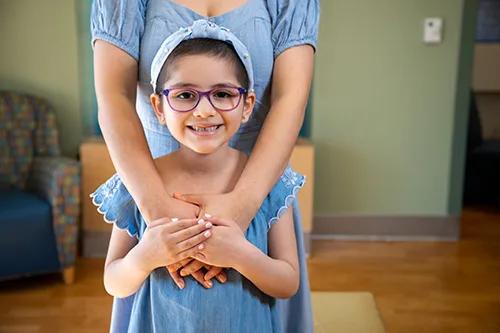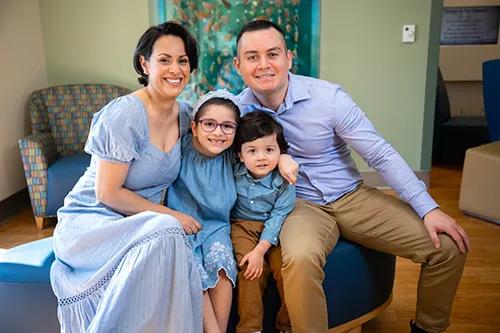
Meet Victoria, who found hope with a game-changing treatment
Victoria was one of the first patients at Children's Health Plano to receive a revolutionary immunotherapy treatment. Now, she’s paving the way for other kids with leukemia.
During the many long months of Victoria’s cancer journey, she’s had two things on her mind: ringing the bell signaling the end of cancer treatment — and what she’ll eat when she no longer has to avoid raw and undercooked foods during chemotherapy.
“I’m going to a restaurant and ordering a steak, medium rare,” Victoria said. “I’m gonna go to Korean barbeque. And I’ll have sushi. And eggs, sunny side up. And maybe some clams or fried shrimp.”
Beyond being an 8-year-old with a sophisticated palate, Victoria is smart and kind. She always takes initiative and loves math and doing science experiments.
But in 2023, Victoria’s journey began with a fever that wouldn’t go away.
“One morning, she woke us at 5 a.m., crying out, 'I can’t breathe,' and saying, 'Something’s wrong, Daddy.' In that moment, we knew we had to act fast, so we rushed her to the ER,” her dad, Carlos, said.
After several tests were run, physicians diagnosed Victoria with Acute Lymphoblastic Leukemia.
“I saw my parents hug and cry. I was in a lot of pain, but I knew I was in good hands,” Victoria said.
Donate Now for North Texas Giving DayEven though her family’s world seemed to crumble, Victoria knew that this was just the beginning of her fight — and that she wasn’t alone. She would fight the diagnosis with the support of her family and health care team at Children’s Health℠.
“The care team spoke to my husband and me with certainty and confidence on how to attack this disease,” her mom, Luzy, said. “At that moment, I felt confident that my daughter would have a second chance in life.”
Learning about leukemia
Victoria had never heard of leukemia. But soon she would learn all about it.

Child life specialist Caroline used cards with pictures to teach Victoria about white blood cells and how leukemia happens when your body makes too many of them. She told her that the treatments she needed to get better may cause body aches and make her feel tired, but she was strong, and she could get through it.
Victoria would need a port, a tiny device placed in the chest area with minor surgery, so doctors could give her the medicine she needed. Caroline showed Victoria exactly what to expect — by demonstrating the procedure on a stuffed animal.
“At first I was scared, but once Caroline showed me, I felt fine,” Victoria said. “When I went to the surgery room to get the port, I told them, ‘I know what’s going to happen.’”
Victoria spent the first month after her diagnosis at Children’s Health.
“We missed Halloween at home, but it was Halloween at the hospital, too,” Victoria said. “We did crafts and picked out a costume.”
Her family was touched by the outpouring of love and support from their care team and community. During an unimaginably hard time, they found comfort in small blessings — like seeing their brave 7-year-old light up with joy, dressed as Wednesday Addams, even while spending Halloween in a hospital room.
A change of treatment plans
Victoria’s treatments stretched on through the weeks and months that followed, each day a new test of strength and hope. What Luzy and Carlos, an MRI Technologist at Children’s Medical Center Plano, didn’t realize was that Victoria was fighting her battle at a remarkable moment when a groundbreaking new treatment was emerging for the very cancer she was facing: B-cell acute lymphoblastic leukemia.

The clinical trial for an immunotherapy drug called Blinatumomab had just been closed early because the treatment was working so well that doctors rushed to make it available to more children.
Victoria’s doctor told Luzy and Carlos about the new research that showed the promise of adding this drug to Victoria's treatment plan: The treatment raised the three-year disease-free survival rate from 88% to 96%, according to The New England Journal of Medicine.
“We were like ‘Yes, right now, where do we sign,’” Luzy said. “It was this great moment that gave us even more hope.”
Victoria would first have the treatment through an infusion at the hospital for a week. Then, they would bring the medicine home for the rest of the 28-day treatment. The medicine was in a backpack, which Victoria decorated with planets and her initials. And she brought it with her everywhere — hanging by her bed when she slept and, in a stroller, next to her while she ate dinner.
“At first, it was hard to always have my backpack, but I got used to it. And then it was easy,” Victoria said.
Victoria was one of the first patients at the Pauline Allen Gill Center for Cancer and Blood Disorders at Children’s Medical Center Plano to receive this treatment. She was excited to tell her doctors what it was like to have this backpack with her 24/7 — and share some tips for other kids who would need one, too.
Back at school
Now, Victoria is in the "maintenance" phase of her treatment, where she has smaller doses of chemotherapy to get rid of any remaining traces of cancer and prevent it from coming back.
After more than a year of nothing but being at home and the hospital, Pediatric Hematologist/Oncologist Tamra Slone, M.D., told her parents that Victoria was in much better health. She could start going back to school — they could go get that Korean barbeque.
“I ate brisket and rice and kalbi and rice cakes,” Victoria said. “And then we got ice cream.”
Victoria is thrilled to be in third grade with her friends. When they ask her why she was out of school for so long, she explains leukemia like Caroline had explained it to her in the hospital.
“We thought she might need to ease back into school slowly,” Luzy said. “But she came home jumping up and down and telling us how she was running around at recess. It was so good to see her go back to her normal environment and be like any other child.”
Victoria will have to wait until after her final chemotherapy treatments in March 2026 to ring the bell and have her steak, medium rare. That’s a day that her whole family looks forward to.
We’ve trusted Children’s Health from the beginning because my husband Carlos works there. But now we’ve really experienced the research, the pioneering care and opportunities – firsthand. We know just how special they are and how well they treat kids.
— Luzy, Victoria's Mom
Meet more Children's Health patients
Read more patient stories like Victoria's and meet our Patient Ambassadors to learn how Children's Health makes life better for children.
How you can help
In order to meet the growing demand of North Texas’ pediatric population, Children’s Health has started construction on its new Dallas pediatric campus, a joint investment with UT Southwestern Medical Center.
Thanks to the support of generous donors, the new Dallas campus will help make the impossible possible for the next generation of kids by providing leading-edge care and emerging treatments for more children like Trevor.
Help kids like Victoria by exploring our ways to give or by giving today!
Kids count on us. We count on you.
Give to support innovative research, lifesaving treatments and compassionate care.
Did you enjoy this story?
If you would like to receive an email when new stories like this one are posted to our website, please complete the form below. We won't share your information, and you can unsubscribe any time.

